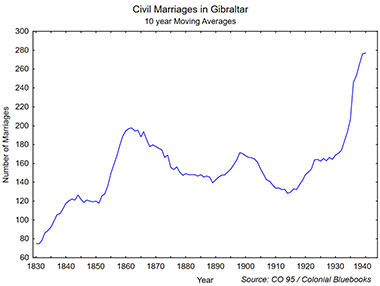Marriage in Gibraltar
1862-1920
The Gibraltar Marriage Register
Compulsory Registration
In Gibraltar, compulsory registration of marriage did not take place until July 17, 1902.
Consequently, the marriage records dated prior to 1902 are incomplete in number (see Figure below).
Non-compulsory registration of marriages started in the 1860s and they are included here with the understanding that they are incomplete.
First a Caveat
In addition to the issue of incomplete registration, there are problems in reading the original script in the marriage document,
typographic errors and omissions. Please be mindful.
Place of Residence
Historically, Gibraltar was divided into 4 distinct geographic areas: the Town, the South, the North Front and Catalan Bay.
For administrative purposes Gibraltar was divided into 28 Districts in the Town proper and 10 Districts in the South.
At the time of marriage, place of residence was recorded by the Registrar by District number and House number (for example D25, H27).
Later the place of residence at time of marriage changed in the first decade of the 20th century.
Under the Public Health Ordinance of 1907, the Sanitary Commissioners caused places of residence
to be numbered and the naming of public highway.
Marriage Age
The information given by the bride and groom at the age at the time of marriage was voluntary.
In some cases, the term of full age means that the individual was of legal age to enter into marriage.
Acknowledgements
Marriages in Gibraltar 1862-1920 online project is a collaboration between Professor. L. Sawchuk, University of Toronto
and Anthony W. Pitaluga, Archivist, Gibraltar National Archives, (anthony.pitaluga@gibraltar.gov.gi).
This work is part of the policy of the Government of Gibraltar to digitize the national record and to make information
more accessible and available to the general public on-line. April 2020.
The information provided is free of charge. In return, please acknowledge Professor. L. Sawchuk, Department of Anthropology,
University of Toronto Scarborough (Lawrence.sawchuk@utoronto.ca), and thank the many U. of T. students who assisted in data entry
and finally, thanks to the Gibraltar Civil Register Office for permission to access the registers.
Disclaimer: The material included here is not an official record of a marriage and as such, solely intended for those interested in appreciating their ancestral roots.
An Overview of Marriage in Gibraltar
The people of Gibraltar have deep family roots that in some cases date back to the 18th century.
As a fusion of Mediterranean, North African and European influences, Gibraltarians are a highly cosmopolitan people.
Notwithstanding their complex biological and social heritage, Gibraltarians stand as a highly cohesive group who look to the
family, kin, neighbours and community as their primary units of social reference and bonds. Strong group identify has been fostered
by their small demographic numbers and their residence within an extremely limited habitable space.
United by a common language and tolerance for others, Gibraltarians have a love of their land so much so
that they are “a cradle to grave community.” Group membership and solidarity have and continue to be reinforced by day-to-day face-to-face meetings.
An important mechanism of fostering group identity is that of marriage. In Gibraltar, marriage is an important social contract that regulates
reproduction, sexuality, child rearing and enculturation, through which spouse preferences are perpetuated over time.
Perhaps, no other social act is so central to the reproduction and maintenance of group boundaries and cultural traditions than marriage.
 Some Reference Works
Some Reference Works
Additional information on marriage in Gibraltar can be found elsewhere; for example, see: Burke, S. D., & Sawchuk, L. A. (2001).
Alien encounters: The jus soli and reproductive politics in the 19th-century fortress and colony of Gibraltar.
The History of the Family, 6(4), 531-561.Burke, S. D., & Sawchuk, L. A. (2007).
Reproductive choices in Gibraltar: a case study of a community in transition, 1960-1996.
Canadian Studies in Population [ARCHIVES], 34(2), 149-178.Gold, P. (2010). Identity formation in Gibraltar: Geopolitical, historical and cultural factors.
Geopolitics, 15(2), 367-384.Haller, D. (2003). Place and ethnicity in two merchant diasporas: A comparison of Sindhis and Jews in Gibraltar.
Global Networks, 3(1), 75-96.Perera, J. B. (2007). The Language of Exclusion in F. Solly Flood's “History of the Permit System in Gibraltar” 1. Journal of Historical Sociology,
20(3), 209-234.Sawchuk, L. A., & Waks, L. (1983). Religious exogamy and gene flow among the Jews of Gibraltar, 1870-1969.
Current Anthropology, 24(5), 661-662. Sawchuk, L. A., & Herring, D. A. (1988). Historic marriage patterns in the Sephardim of Gibraltar, 1704 to 1939.
Jewish Social Studies, 177-200.Sawchuk, L. A. (1992). Historical Intervention, Tradition, and Change: A Study of the Age at Marriage in Gibraltar, 1909–1983.
Journal of Family History, 17(1), 69-94.
Notes
i Sawchuk, L.A. and S.D.A. Burke 1997 Through the Looking Glass: An anthropological Reflection on the Roots of the Gibraltarian People.
Memoirs GibCEMED Vol. 1:5-32.